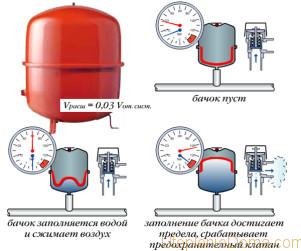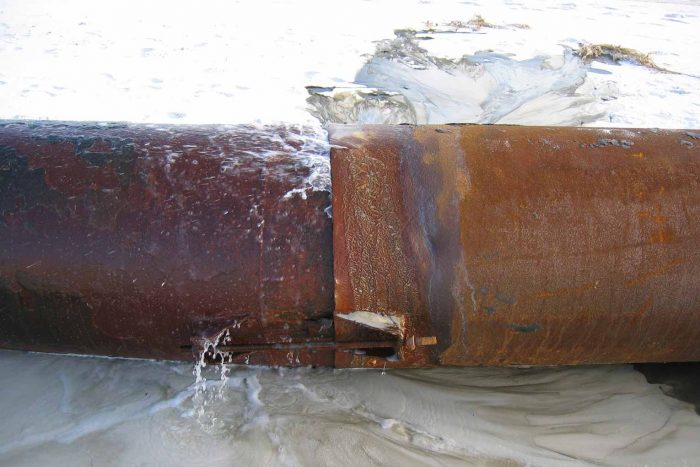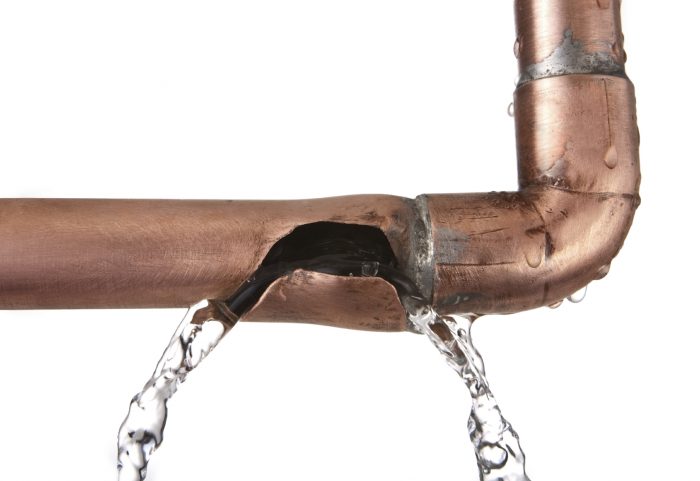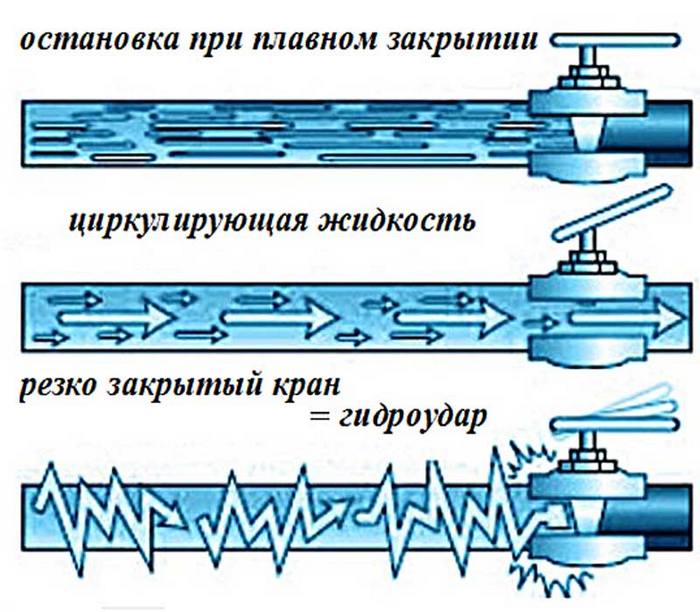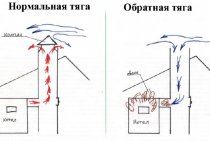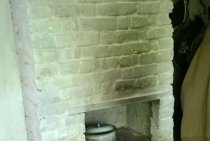Basic Prevention Measures
In addition to strict adherence to all established operating rules, it is possible to prevent the occurrence of an accident by if timely and regularly take preventive measures. The whole reason is that in the main heating or water supply system, absolutely all processes are closely interconnected. A water hammer unexpected by the user is just the final destructive stage, which may well lead to various negative consequences. All this happens against the background of a relatively poor technical condition of pipes used for years.
The pressure drops and the resulting vibrations only contribute to the formation of various cracks in the thickness of the metal. Over time, more serious defects occur, which, after the onset of water hammer, instantly appear in areas of too high internal stress. These can be various places of bends, mechanical connections and even welds.
Preventive manipulations include the following steps:
- Timely check of the pressure behind the elastic membrane of the operating expansion vessel. If during this procedure the wizard finds unsatisfactory results, then it is forbidden to operate the system without a qualitative adjustment.
- Checking the health of the involved security groups. This applies to the air vent, safety valve, as well as the classic pressure gauge.
- Control of the position of the valves involved shut-off and control metal fittings.
- Periodically check the status of all filters. These elements are responsible for the retention of fine sand, classic scale, rust fragments. If necessary, the master needs to clean and then rinse the filters.
- Testing the system in use for leaks. You also need to check the degree of wear of all elements.
Many experts recommend replacing the classic rigid pipe with a plastic product. It is more flexible in application and is able to expand rapidly under pressure. But you need to be careful, since depressurization of the joints is not excluded.
A professional approach to prevention, which is aimed at the general maintenance of the optimal state of the heating and water heating system, necessarily includes elementary types of work. It is not recommended to ignore this step. This is due to the fact that the repair of heating in a private house entails a large expenditure of finances and free time. All the described protection measures will be effective if you approach the work comprehensively. Only in such a situation it is possible to neutralize various undesirable consequences and extend the period of coordinated operation of the system.
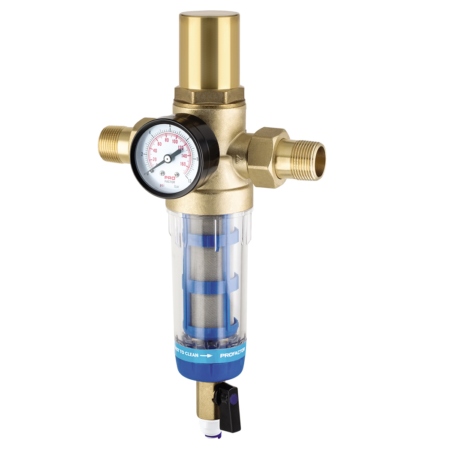
Drops and their causes
Pressure surges indicate that the system is not working properly. The calculation of pressure losses in the heating system is determined by summing up the losses at individual intervals that make up the entire cycle. Timely identification of the cause and its elimination can prevent more serious problems that lead to costly repairs.
If the pressure in the heating system drops, this may be due to such reasons:
- the appearance of a leak;
- failure of the expansion tank settings;
- failure of pumps;
- the appearance of microcracks in the boiler heat exchanger;
- power outage.
How to increase the pressure in the heating system?
Expansion tank regulates pressure drops
In the event of a leak, check all connections. If the cause is not visually identified, it is necessary to examine each area separately. To do this, the valves of the cranes alternately overlap.The pressure gauges will show the change in pressure after cutting off one or another section. Having found a problematic connection, it must be tightened, previously additionally compacted. If necessary, the assembly or part of the pipe is replaced.
The expansion tank regulates the differences due to heating and cooling of the liquid. A sign of a tank malfunction or insufficient volume is an increase in pressure and a further decline.
To the result obtained, a gap of 1.25% should be added. The heated liquid, expanding, will force the air out of the tank through the valve in the air compartment. After the water cools, it will decrease in volume and the pressure in the system will be less than necessary. If the expansion tank is smaller than required, it must be replaced.
An increase in pressure can be caused by a damaged membrane or an incorrect setting of the pressure regulator of the heating system. If the diaphragm is damaged, the nipple must be replaced. It's fast and easy. To set up the tank, it must be disconnected from the system. Then pump the required amount of atmospheres into the air chamber with a pump and install it back.
You can determine the malfunction of the pump by turning it off. If nothing happens after shutdown, then the pump is not working. The reason may be a malfunction of its mechanisms or lack of power. You need to make sure that it is connected to the network.
If there are problems with the heat exchanger, then it must be replaced. During operation, microcracks may appear in the metal structure. It can't be fixed, only replaced.
Why does the pressure in the heating system increase?
The reasons for this phenomenon may be improper circulation of the fluid or its complete stop due to:
- the formation of an air lock;
- clogging of the pipeline or filters;
- operation of the heating pressure regulator;
- incessant feeding;
- blocking valves.
How to eliminate gaps?
An airlock in the system does not allow fluid to pass through. Air can only be bled. To do this, during installation, it is necessary to provide for the installation of a pressure regulator for the heating system - a spring air vent. It works in automatic mode. Radiators of the new sample are equipped with similar elements. They are located at the top of the battery and work in manual mode.
Why does the pressure in the heating system increase when dirt and scale accumulate in the filters and on the pipe walls? Because the fluid flow is obstructed. The water filter can be cleaned by removing the filter element. Getting rid of scale and clogging in pipes is more difficult. In some cases, washing with special means helps. Sometimes the only way to fix the problem is to replace the pipe section.
The heating pressure regulator, in the event of an increase in temperature, closes the valves through which liquid enters the system. If this is unreasonable from a technical point of view, then the problem can be corrected by adjusting. If this procedure is not possible, replace the assembly. In the event of failure of the electronic control system of the make-up, it should be adjusted or replaced.
The notorious human factor has not yet been canceled. Therefore, in practice, shut-off valves overlap, which leads to increased pressure in the heating system. To normalize this indicator, you just need to open the valves.
Possible consequences of water hammer and its danger
You can recognize the signs of the phenomenon by extraneous sounds in the system: clicks, knocks, collapses. Visual signs will also help: leaking taps, mixers, compression fittings-connectors with rubber gaskets.
When the water supply system is subjected to frequent water hammering even of weak force, gaskets and seals are squeezed out first. Violation of the tightness of the system can lead to the appearance of foci of deformation and rupture of pipes.
As a result of the increase in pressure, the water supply is interrupted.But this is not the only trouble. If a water hammer has led to a complete rupture of a pipe, for example, in an apartment building, the entire structure remains without water. The flow of liquid spoils the property of the owners of the apartment, the neighbors of the lower floors are flooded. As a result - work on the repair and restoration of several housing facilities.
Water hammer in the hot water supply system threatens, in addition to the final damage to property, burns. The danger threatens when the heating system is depressurized, where the carrier maintains a temperature of + 70 ° C and is constantly under pressure. A battery or pipeline rupture during the winter heating season will disable the system. Frosts will finish the destructive work - the pipeline will have to be changed.
Causes of water hammer
The main reason is the abrupt closure of the valves. If the water flows in a thin stream, the risk is minimal, but with sudden opening / closing of the tap, the danger is maximized.
Why else does water hammer occur in the water supply system:
- With sudden switching on of powerful pumps. Occurs when the power supply of objects equipped with powerful pumping stations is unstable.
- In the presence of air jams in the water supply, heating system. Therefore, before putting into operation closed systems with a liquid carrier, you must first bleed the air.
Today, water hammer is considered the most common factor in the failure of water supply systems. This is due to the emergence of new shut-off valves that do not require long turns of the valve (tap) to open / close water.
Introduction of shock absorbers
The hydraulic accumulators and absorbers being sold today are capable of simultaneously performing several important functions at once. They not only collect liquid, but also eliminate excess water from the system, and also help prevent various undesirable manifestations. Hydraulic accumulators perform all the functions of compensating units. They are installed only in the direction of the main water flow in those sections of the heating circuit, where the probability of a sudden decrease or increase in the measured pressure level is especially high.
A kind of extinguisher, as well as a hydraulic accumulator, in practice, are a capacious steel flask, which can easily fit up to 35 liters of liquid. They include at once two sections separated by a durable rubber or rubber partition. In the event of an increase in pressure, all hydraulic shocks are redirected to the reservoir. Due to the bending of the involved membrane at the moment of a sharp rise in performance, specialists manage to achieve the effect of forced expansion of the circuit.
Pipes made of heat-resistant reinforced rubber or elastic plastic act as shock-absorbing elements. To achieve the desired effect, it is enough to use a product with a length of 35 centimeters. If the pipeline is very long, then the shock absorber section must also be increased by at least 12 cm.
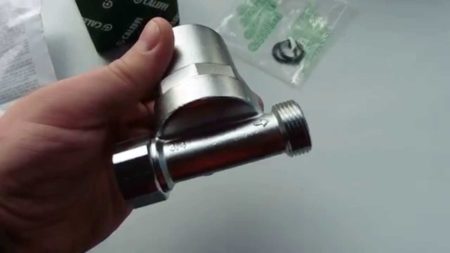
What is water hammer in a water supply system
Water hammer is a short-term powerful increase in the pressure of the liquid that circulates in the pipes. The pressure increases due to the change in the flow rate.
The sign of pressure change affects the type of water hammer:
- positive - at which the pressure rises due to the sudden closing of the valve or the inclusion of the pumping unit;
- negative - at which pressure increases due to pump stop.
According to the laws of physics, even with a sharp closing of the tap, the water continues to move. Only the flow closest to the valve stops, the remaining layers continue to flow. The collision of the stopped and moving layers causes an increase in pressure. If we imagine that the entrance was abruptly closed in front of the moving crowd, then the first rows have already stopped - the next ones stumble upon them, continuing to go, it turns out a crush.Water also acts, which causes water hammer.
The pressure rises in an instantaneous mode, the level increases by several tens of atmospheres. The consequences cannot be avoided.
Water hammer theory
The occurrence of the phenomenon is possible only due to the lack of compensation for pressure drops. A jump in one place causes the force to spread along the entire length of the pipeline. If there is a weak point in the system, the material can be deformed or destroyed completely, a hole is formed in the system.
The effect was first discovered at the end of the 19th century by the Russian scientist N.E. Zhukovsky. He also derived a formula by which one should calculate the period of time required to close the tap in order to avoid unpleasant consequences. The formula looks like this: Dp = p(u0-u1), where:
- Dp is the pressure increase in N/m2;
- p is the liquid density in kg/m3;
- u0, u1 are the average indicators of the water velocity in the pipeline before and after the valves are closed.
To know how to prove water hammer in a water supply system, you need to know the diameter and material of the pipe, as well as the degree of compressibility of water. All calculations are carried out after establishing the water density parameter. It differs in the amount of dissolved salts. The determination of the rate of propagation of hydraulic shock is carried out according to the formula c = 2L/T, where:
- c is the designation of the shock wave velocity;
- L is the length of the pipeline;
- T is time.
The simplicity of the formula allows you to quickly identify the speed of impact propagation, which, in fact, is a wave with oscillations of a given frequency. And now about how to find out fluctuations per unit of time.
For this, the formula M = 2L / a is useful, where:
- M is the duration of the oscillation cycle;
- L is the length of the pipeline;
- a is the wave speed in m/s.
Simplifying all calculations will allow knowing the indicators of the shock wave velocity upon impact for pipes made of the most popular materials:
- steel = 900-1300 m/s;
- cast iron = 1000-1200 m/s;
- plastic = 300-500 m/s.
Now you need to substitute the values in the formula and calculate the frequency of the water hammer oscillations in the section of the water pipe of a given length. The theory of water hammer will help to quickly prove the occurrence of the phenomenon and prevent possible risks when planning the construction of a house or replacing a plumbing or heating system.
Basic protection methods
To protect materials, equipment and communications from hydraulic shocks, the following methods are used:
- Installation of thermostats with built-in shunt;
- Inserts made of plastic material;
- Installation of membrane devices;
- Control of the pump operation modes according to the pressure sensor data in the system;
- General preventive measures.
As shutoff valves, thermostats with a built-in shunt are installed. A shunt is a tube of small diameter that allows excess coolant to pass through when the pressure rises.
Steel elements are most often subject to destruction from water hammer due to the rigidity of the structure, the absence of a shock-absorbing effect. To create a shock absorber, small sections of polymer pipes are often embedded, which have good flexibility. In the event of a water hammer, they compensate for the impact force by bending, while not being damaged.
Hydraulic accumulators and expansion tanks also do a good job of increasing pressure, taking on its excess. The membrane, made of rubber or polymer, bends, compresses the air of the air chamber. Water from the heating enters the vacated space, and the total pressure in the system decreases.
Circulation pumps are equipped with a pressure control system. The sensor controls the water pressure in the network. When the value is increased, it commands the pump speed to be reduced. Such a system is applicable for pumps with frequency control of the impeller rotation speed.
General preventive measures to prevent water hammer and their consequences:
- Perform smooth control of shut-off valves;
- Turn on the pumps at low speed;
- Check the operation of air vents and safety valves;
- Timely, regularly bleed air from the equipment;
- Regularly perform a visual inspection for the integrity of the heating structural elements;
- Monitor the integrity of the expansomat membrane.
Water hammer is a frequent and dangerous phenomenon in heating networks. Their timely prevention will save heating communications and equipment from damage, preserve their integrity and performance.
Owners of private apartments and houses often hear sharp, distinct blows in the equipped heating pipeline. Many do not pay due attention to this phenomenon, but the outcome of the situation can be very different. Specialists often have to eliminate the results of the destruction of important parts.
In some cases, injury to residents is not ruled out. Water hammer in an equipped heating system is the main cause of most breakdowns and destruction of heating equipment. A high-quality and timely solution of this issue is of great importance for the stable and trouble-free operation of the system.
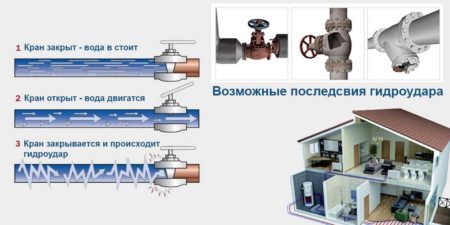
Complete set of thermostatic valve
This accessory is a compact tube. The final clearance can vary from 0.2 to 0.6 millimeters. The shunt is mounted in the direction of the circulating fluid. The main task of the part is to gradually reduce the pressure when overloads are detected. When designing autonomous systems, the shunting method is necessarily used, since only in this case it is possible to protect the new pipeline from failure.
This effect is due to the presence of rust and other debris in worn pipes, which is a serious obstacle to achieving the desired result. It is for this reason that it is advisable to install high-quality water filters at the very outlet to the equipped heating circuit during the use of the shunt.
Short description
A very common water hammer in a well-equipped high-quality heating system is a peculiar phenomenon, which is based on the norms of the dynamics of various substances. The manifestation itself is different in that with a periodic change in the speed of the flow of the working fluid, an increase in pressure indicators is observed. The main coolant is water, the main indicator of which is incompressibility. During the circulation of the charged coolant through pipelines and heating elements, various hydraulic obstacles may occur on its path. In most cases, these are turns, sharp changes in the diameter of pipelines, as well as shut-off and control valves.
Under adverse conditions created, the coolant can damage those elements that present strong hydraulic resistance to the flow. These can be convectors, pipe bends, various appliances, radiators and even boiler heat exchangers.
An accident may well arise as a result of the gradual wear of the operated structure and its elements, or as a result of a sudden impact of a strong jump in performance. In all situations, the consequences of a water hammer entail material waste to eliminate the leak. In order not to find yourself in such a situation, you should understand the basic causes of the formation of water hammer. The consequences of an accident are always unpredictable, ranging from the most common breakdown of the circulation pump to large-scale flooding of the entire house. It all depends on the quality and power of the system.

Gradual shutdown of the system
This is one of the most important requirements when starting and then turning off the heating installation. All optimal parameters are described in detail in the basic accompanying documents.The whole reason is that the accumulated water hammer energy, due to the increased strength of the pipe walls, may not act with all its power.
This feature is achieved due to lightning-fast bending in the right direction. With an equal final impact force, the indicator of the power of influence on a certain section of the system will significantly decrease. Thanks to smooth switching on, specialists can significantly extend the rate of pressure increase in time, minimizing the likelihood of damage to the heating system of a cottage or apartment building.
Batteries gurgling
The next cause of noise in metal heating pipes is air. If something continuously boils and gurgles in the battery, as in the stomach of a sick cow, it is, dear. Sound insulation of heating pipes, even if it were carried out, would not give anything - the sound will be heard through the walls of the radiator.
Are you on the top floor of a house with a bottom outlet (when both the supply and return pipes of the heating system are located in the basement)? Then look for a Mayevsky faucet on a radiator or a jumper between adjacent rooms - a device that helps to bleed air.
In all other cases, it is worth looking for a counterslope (of course, if the heating system works normally in all other respects, except for noise). A radiator hanging skewed or a section of the connection to it, which is lower at the riser than near the battery itself - this is what you have to fix, and most likely in the summer - it is hardly possible to stop the heating system in winter for a long time, especially in the harsh climate of Siberia or the Far East would be a good idea.
